Solis Barista Perfetta Plus Test and Review: a homebarista starter kit
One comment↓ specifications & manual ↓↓ colors & prices ↓
Solis is a Swiss brand mostly notable for its entry-level Solis Scala conical burr grinder, which is one of the best choices for home in a low budget. However, they have never produced espresso machines. As far as I know, Solis just branded Sage/Breville for some European countries (mainly Switzerland and Netherland). And years ago they used to sell Solis Master 5000 – a bullet-proof fully-automatic espresso machine, which was a rebadged Saeco machine.
Finally, at IFA 2019 Solis presented its first “own” model. And since 2020 the Solis Barista Perfetta Plus Type 1170 espresso maker (Solis 98007 on the German market) is widely sold all around Europe. Yep, this review is not for my US-based readers.
I put “own” in the quotation marks because it’s hard to launch a completely new machine from scratch nowadays. The Barista Perfetta is produced in China – which is normal for at-home semi-automatic machine – and is clearly based on the chassis, which is very similar to the one that Breville/Sage uses. Still, there are many changes and Solis-only features that make this machine interesting to test.
1. Technical information: what’s inside?
1.1. Thermoblock as a heating element
Solis Barista Perfetta Plus (not to be confused with an older Solis Barista Perfect Pro) is a thermoblock-based model. This means that the machine is:
- Fast if compared to boiler-based models. That’s because the heating element works like a tankless water heater, there is no need to wait till the whole boiler will be warmed up. However, for better espresso, it’s still highly recommended to wait 5+ minutes to warm the group head and the portafilter.
- Compact. Thermoblocks are compact, that’s why they are widely used for narrow espresso machines. Delonghi Dedica EC680/685 (world bestseller in the class), as well as Krups Calvi, are good examples. Solis Type 1170 plays in the same league – it is just 19 cm wide.
On the other hand:
- The temperature is less stable, which is crucial for a bar-quality espresso. The first sign, which tells us that this machine is the at-home model, not a professional device.
- Despite remarkable narrowness, Solis’ new espresso maker is quite deep. The depth is 37 cm + leave some space for the power cord.
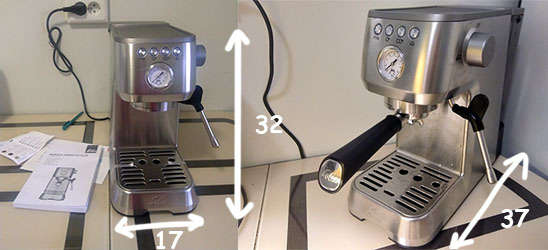
Additionally, Perfetta Plus has a drainage function. When you are done with milk frothing that is performed at approx. 140°C the machine automatically flushes the hot water out of the thermoblock and fills it with fresh cold water. This allows you – as a user – to start brewing your next cup of coffee almost immediately after steaming, no need to wait for cooling down. The above-mentioned Delonghi Dedica, for example, doesn’t have such feature.
Krups Calvi does, by the way. But it has a very limited drip tray that becomes full after 2-3 cappuccinos. And here I should note that a 450-ml drip tray of Solis is big enough for such water-consumption technology. At average it will be enough to empty the tray every 10-15 espressos or 4-5 cappuccinos.
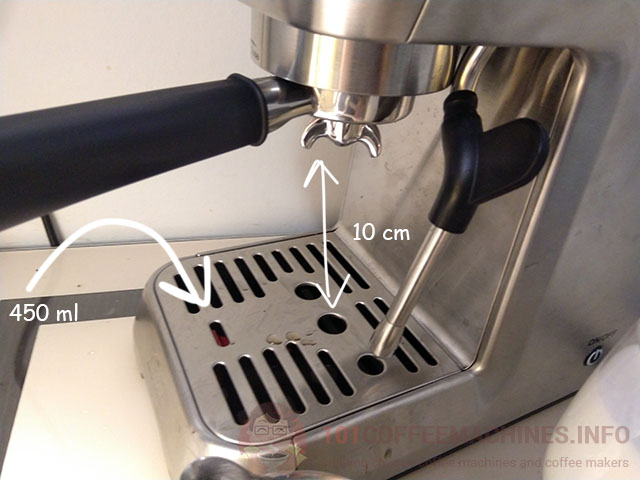
1.2. Semi-professional features
Solis Barista Perfetta Plus is equipped with some features that usually are introduced on more professional machines.
First of all, it’s a 3-way solenoid valve, which – unexpectedly – isn’t specified in the official technical data. However, I personally checked the machine’s internals to locate a 3-way valve and received a confirmation from Solis that all the machines have it.
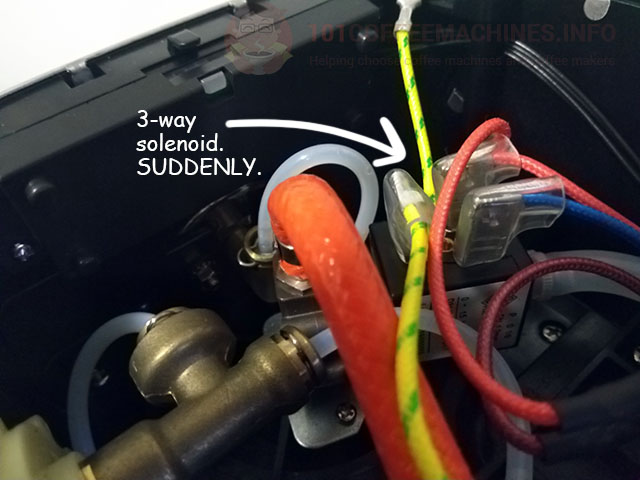
This valve immediately stops the extraction process sucking off all the water from the filter basket. The benefits are the following:
- No over-extracted coffee continues to come out in drips spoiling your shot or the shiny metal cup stand (in case you are quick enough to remove the cup as soon as brewing ends).
- The coffee puck is dry, not wet, and can be easily knocked out of the portafilter.
- You can eject the portafilter immediately after brewing – there would be no residual pressure inside. Thus, you don’t risk to get coffee splashes all over your kitchen.
- It keeps the thermoblock clean because the back-pressure pushes coffee into the drainage, not back inside the heating element.
Secondly, it’s a manometer (pressure gauge). In the last 2-3 years, it became popular to put round dial thermometers on the cheap espresso makers. This trick gives a professional/retro look. However, these thermometers are usually quite a useless function, the pressure is more important. Here, on the Solis Perfetta Plus, we have a real pressure gauge like on Delonghi La Specialista. Moreover, it’s installed in the right place – in the group head.
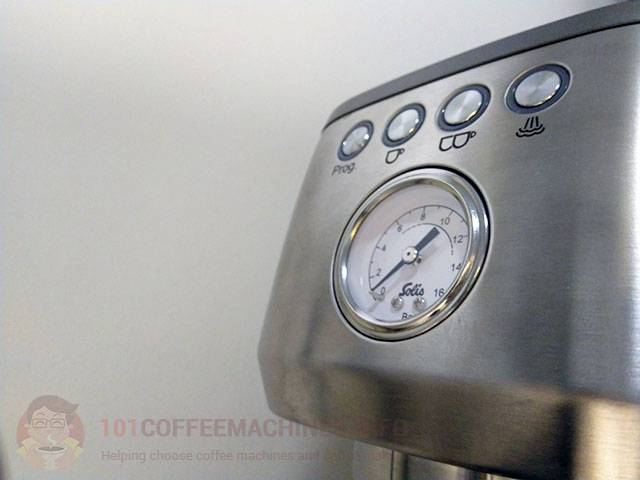
The third distinction is a 54-mm group head with both pressurized (for preground coffee and for beginners) and unpressurized (professional, to be used only with a good burr grinder) filter baskets. Most of the espresso machines for home have 51mm diameter and are equipped only with pressurized baskets.
I can’t ultimately say that the bigger diameter = better espresso. There are many nuances and Italian La Pavoni, for example, still uses 51mm baskets. However, in most of the cases the bigger = the better.
Finally, Solis Type 1170 has a steam wand of the professional type, while the majority of at-home espresso makers have panarellos. I will write about it with more details below.
2. All accessories in the box
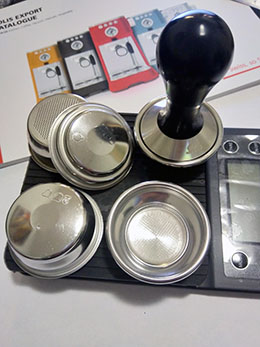
- 5 filter baskets, which I mentioned above: two pressurized (1-cup and 2-cup), two unpressurized + one for ESE pods.
- 54mm metal tamper, quite good, it’s weight is 365 grams
- Rubber disc to turn the filter into the blind filter, this is for cleaning
- 300-ml milk pitcher, could be better (too thin metal) and bigger (for this particular steam wand)
- Brita water filter, brush for cleaning, plastic scoop, water hardness test.
That is almost everything you need for everyday use except descaling liquid and tablets for cleaning coffee oils in the group head.
3. Build quality
While I disassembling the machine (to check if there really is a 3-way solenoid) I noticed few things:
- First of all, it’s quite easy to get inside the machine. I’ll put the maintainability in the pros list.
- Under the brutal metal “outfit” of this Solis espresso maker you will find a lot of plastic parts. For this class, it’s always the case. So I was not surprised to see the plastic frame, plastic water tubes… In other words, plastic is everywhere, where it can be used.
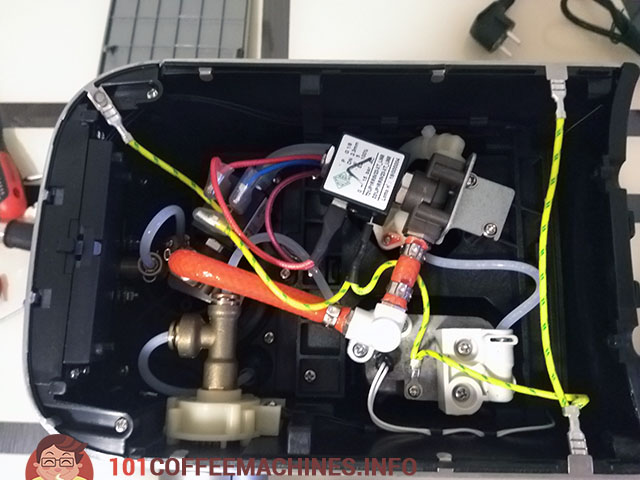
- But I’m especially disappointed by the inner parts of the group head, because its plastic insides affect the espresso taste. That’s because plastic is less efficient in conducting the heat, as a result – it is hard to heat the portafilter well. And this results in underextraction, this Solis tend to brew a bit sourer than competitors if all other things being equal. For the same reason, the passive cup warmer plate on top is warming very slowly – better warm up your cups by putting them under the steam or hot water.
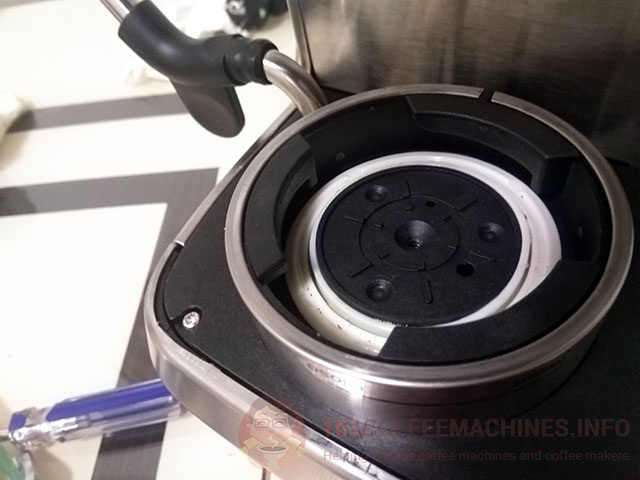
The portafilter itself is good, by the way. It’s heavy and made of steel under the chrome plating. For some reason, they put a plastic “floor” inside, which has no functional meaning. Hopefully, it easy to remove it.
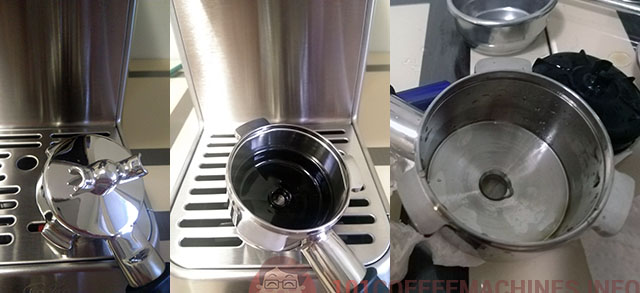
4. Steam Wand/Milk Frothing
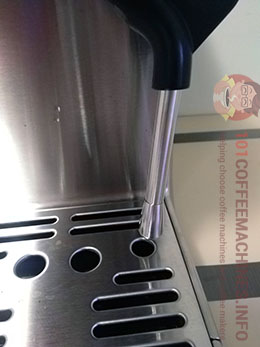
- It is not a panarello, it’s a steam wand like on professional machines. Beginners will need to exercise a few days to handle it, but in the hands of an experienced user, it can deliver soft, creamy milk foam with no big bubbles. On panarello even the most professional barista simply can’t froth as good as on the “normal” steam wand.
- It rotates in any direction, so there would be no problem to move the wand into the most comfortable position.
- Moreover, in the extreme position, it doesn’t stick out (so you don’t need extra space on the right of the coffee maker) and is located just above the specially designed hole in the drip tray. You can use this position to drain water/steam for the milk frother without making a mess.
On the other hand:
- Steam power isn’t very strong and a bit wet. That’s because of thermoblock, it can deliver steam for a long time, but can’t make it super-dry and super-powerful. For the same reason, there is only one output hole on the bulb.
- A strange decision by engineers of this coffee maker to put the steam in the soft silicon tube, which come inside the solid metal tube:
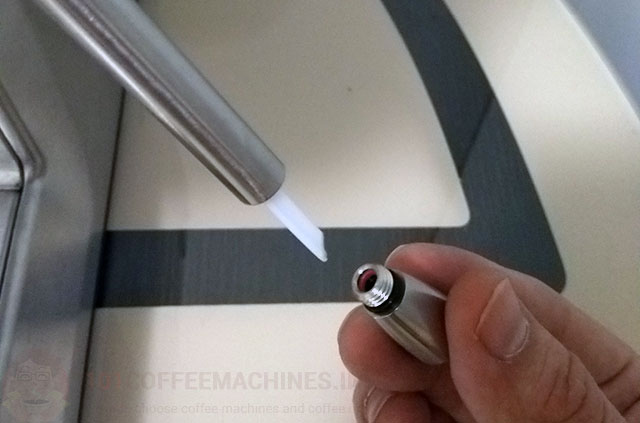
Probably, they didn’t manage to make a ball joint in any other way? Or maybe this is not a bug, but a feature that prevents potential burn of your fingers? Usually steam wands on other machines a quite hot after frothing, here on Solis the metal steam wand is indeed just warm, not hot.
6. Few more observations:
- Solis Barista has an adjustable automatic shut-down timer.
- Each of two recipes (espresso and double espresso) stops automatically as soon as the programmed volume is reached. By default, it’s 30 ml for a single espresso. You can reprogram it (up to 300 ml).
- The pre-brewing/pre-infusion pause isn’t adjustable. The machine always injects approx. 5 ml of water, then it stops (3 seconds), then continue brewing. This is useful when you use preground coffee to make aroma richer, but with freshly ground coffee I personally would prefer to disable it.
- On IFA 2019 five color options were announced. Currently, only three of them are available on the market: metallic silver (the one, which I tested), red and black. Probably, two more colors (yellow and blue) will be launched later.
7. Espresso quality and conclusions
My overall experience with milk frothing on this machine is positive. Yes, making milk foam may require a longer time than on boiler-based machines, but Solis is quite efficient and – what is most important – in terms of milk foam it can compete with professional devices.
In terms of espresso quality, I could give this machine 4 out of 5. It makes decent, strong shots. The only problem – it is hard to evenly warm up the machine, especially the group head. That’s why this Solis tends to brew a bit sourer, but still, it’s one of the best espressos you can brew on the machine of this class.
By “this class” I mean the class of at-home espresso machines designed to be used by amateurs, not professionals or espresso-geeks. If you are one of the latter – let’s be honest – you will find a less automated, but more professional machine for this price.
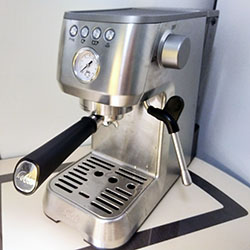
Surely, the cheaper Gaggia Classic 2019 will brew even better espresso with almost unlimited ways to upgrade it. However, it will require more experience, more plays around, more time and more space on your counter table. If you are ready to “go hard” than I think it’s better to choose Gaggia Classic.
If unsure – Barista Perfetta Plus is a golden middle between professional equipment and purely amateur espresso machine. Just a bit overpriced in my opinion.
P. S. This machine is also good as a present: all the accessories are in the box + it can fulfill the needs of a complete newbie and a more experienced home barista. However, if you drink only espresso, then there is a better and cheaper, yet a bit more “ugly”, alternative – Gaggia Viva, here is my review.
I NEED your opinion. Please rate my review:
Solis Barista Perfetta Plus Type 1170 Coffee Machine Specifications: |
|
|---|---|
| Download manual: | Download pdf manual |
| Machine type: | Pump espresso machine |
| Width х Deep х Height: | 18 x 37 x 32 cm |
| Coffee used: | Ground coffee or E. S. E. pods |
| Grinder: | No |
| Brewing group: | 54mm, chrome-plated steel with pressurized and unpressurized filters |
| Heater: | Thermoblock 1700 W |
| Max pressure: | 15 bar |
| Water container: | 1.9 l (accessible from top) |
| Cappuccinatore: | Professional steam wand (steamer) |
| Max cup height: | 10 cm |
| Controlling: | Electronic with autodosage and prebewing |
| Peculiar properties: | 3-way solenoid valve, pressure gauge (manometer) |
| Colors: | Red, Silver/Silber, Black. Yellow, Blue coming soom. |


 (44 votes, average: 4.27 out of 5)
(44 votes, average: 4.27 out of 5)

Hi Sorry to bother you. (I wrote a message on Youtube as well but this might work better), I have the Solis Perfetta Plus. I have tried everyting humanly possible to get a decent espresso from it but I failed so far. the result is either sour of, when I grind to fine) bitter. I used 18/19 grams and aim for 36 grams out. In under 30 seconds. Obviuously the reults vary a bit but overall SOUR. I used different tamping methods (palm tamper snd OCD knockoff) nothing works. I did notice after the pull there allways is a small dent in the puck at the same spot. Can not do much about the temperature can I? I do heat up the machine long and flush it several tiomes. Or should a try to change the plastic parts? Any other advice? Maybe choose e specific coffee that is not less likely to get sour? Thanks a lot for your help!! Greets from the Netherlands
steven scholten
25 Mar 20 at 9:41 am